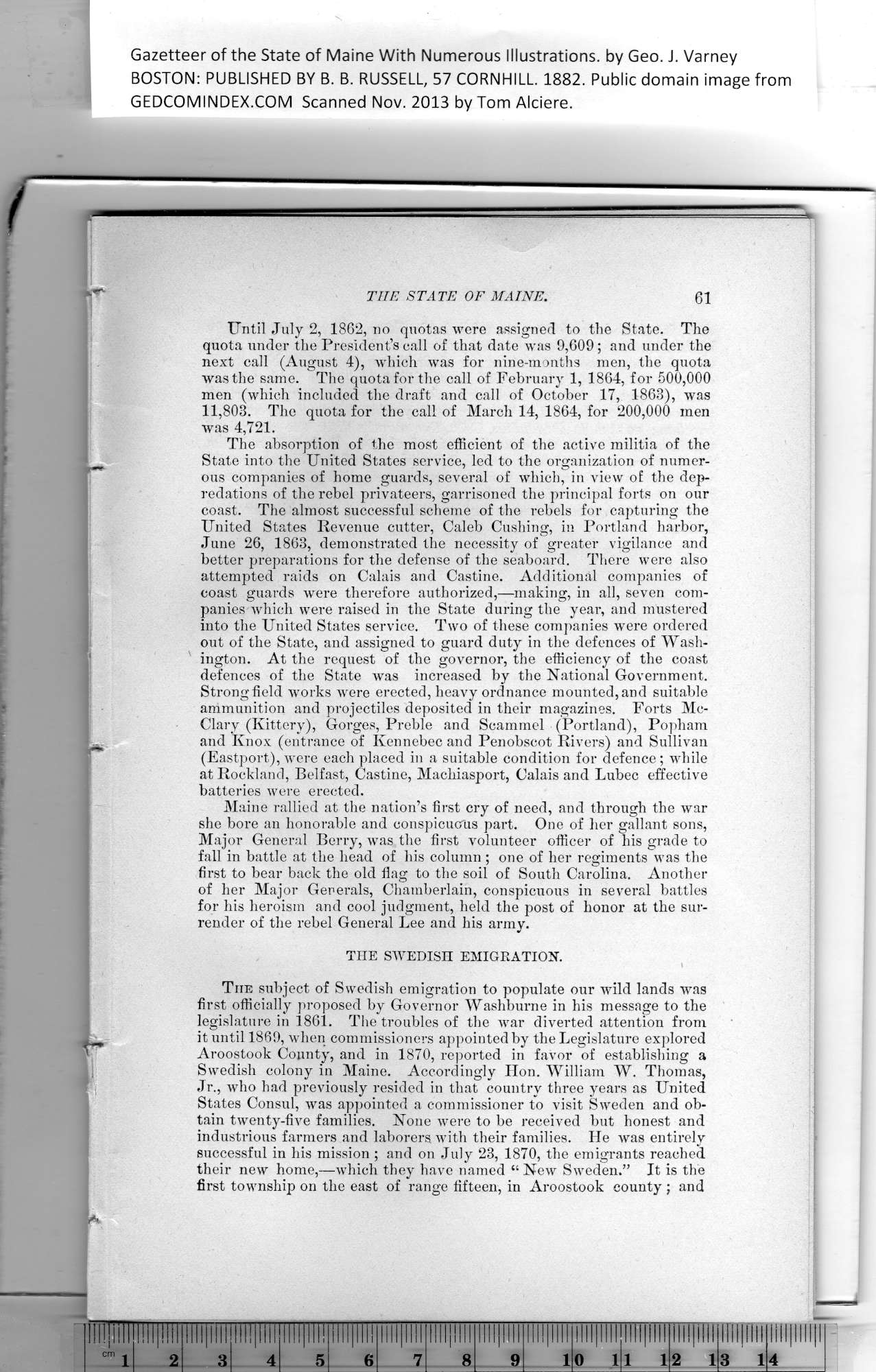|
Gazetteer of the State of Maine With Numerous Illustrations, by Geo. J. Varney
BOSTON: PUBLISHED BY B. B. RUSSELL, 57 CORNHILL. 1882. Public domain image from
THE STATE OF MAINE.
Until July 2, 1862, no quotas were assigned to the State. The
quota under the President’s call of that date was 9,609; and under the
next call (August 4), which was for nine-months men, the quota
was the same. The quota for the call of February 1, 1864, for 500,000
men (which included the draft and call of October 17, 1868), was
11,803. The quota for the call of March 14, 1864, for 200,000 men
was 4,721.
The absorption of the most efficient of the active militia of the
State into the United States service, led to the organization of numer-
ous companies of home guards, several of which, in view of the dep-
redations of the rebel privateers, garrisoned the principal forts on our
coast. The almost successful scheme of the rebels for capturing the
United States Revenue cutter, Caleb Cushing, in Portland harbor,
June 26, 1863, demonstrated the necessity of greater vigilance and
better preparations for the defense of the seaboard. There were also
attempted raids on Calais and Castine. Additional companies of
coast guards were therefore authorized,—making, in all, seven com-
panies which were raised in the State during the year, and mustered
into the United States service. Two of these companies were ordered
out of the State, and assigned to guard duty in the defences of Wash-
ington. At the request of the governor, the efficiency of the coast
defences of the State was increased by the National Government.
Strong field works were erected, heavy ordnance mounted, and suitable
ammunition and projectiles deposited in their magazines. Forts Mc-
Clary (Kittery), Gorges, Preble and Scammel (Portland), Popliam
and Knox (entrance of Kennebec and Penobscot Rivers) and Sullivan
(Eastport), were each placed in a suitable condition for defence ; while
at Rockland, Belfast, Castine, Machiasport, Calais and Lubec effective
batteries were erected.
Maine rallied at the nation’s first cry of need, and through the war
she bore an honorable and conspicuous part. One of her gallant sons,
Major General Berry, was the first volunteer officer of his grade to
fall in battle at the head of his column ; one of her regiments was the
first to bear back the old flag to the soil of South Carolina. Another
of her Major Generals, Chamberlain, conspicuous in several battles
for his heroism and cool judgment, held the post of honor at the sur-
render of the rebel General Lee and his army.
THE SWEDISH EMIGRATION.
The subject of Swedish emigration to populate our wild lands was
first officially proposed by Governor Washburne in his message to the
legislature in 1861. The troubles of the war diverted attention from
it until 1869, when commissioners appointed by the Legislature explored
Aroostook County, and in 1870, reported in favor of establishing a
Swedish colony in Maine. Accordingly Hon. William W. Thomas,
Jr., who had previously resided in that country three years as United
States Consul, was appointed a commissioner to visit Sweden and ob-
tain twenty-five families. None were to be received but honest and
industrious farmers and laborers with their families. He was entirely
successful in his mission ; and on July 23, 1870, the emigrants reached
their new home,—which they have named “ New Sweden.” It is the
first township on the east of range fifteen, in Aroostook county; and
PREVIOUS PAGE ... NEXT PAGE
This page was written in HTML using a program written in Python 3.2
|
